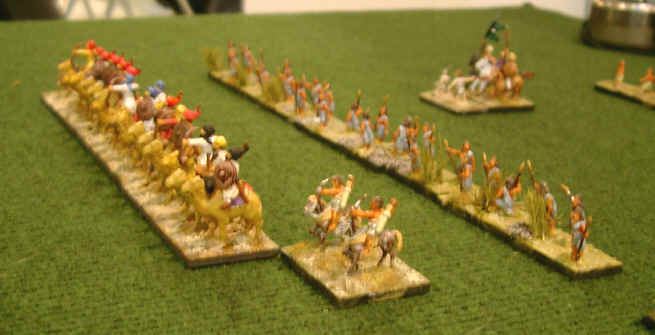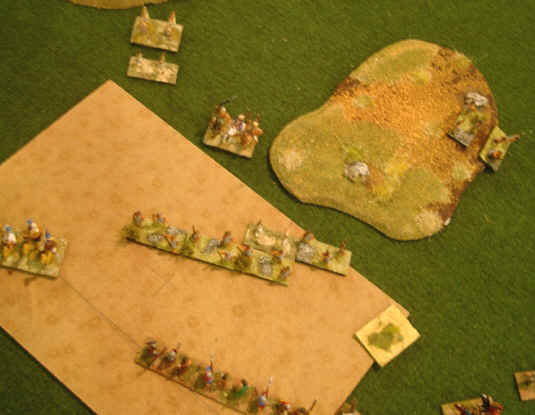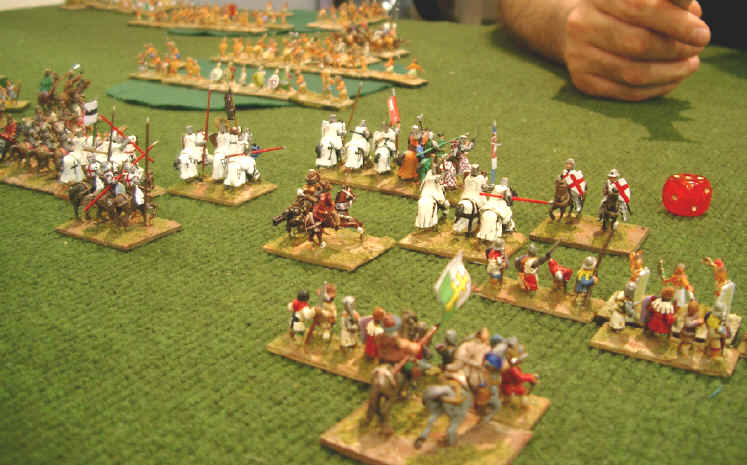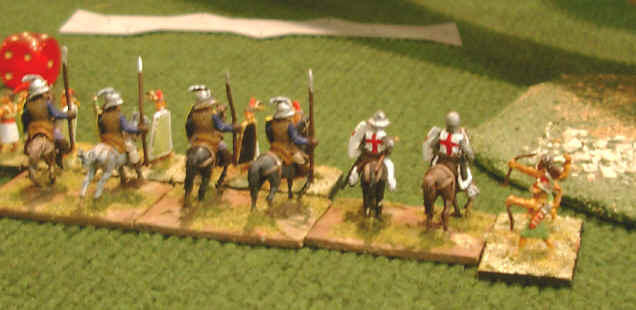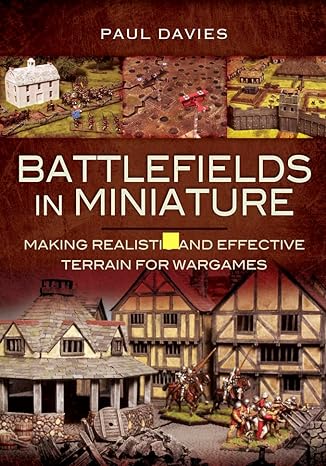IWF 2006 Athens
Game 4 - Saturday AfternoonAfter a wonderful lunch of little squids and five pints of lager I was delighted to find myself playing a tough opponent and even tougher army - Massimiliano and a doubtless enormous and unkillable Quataban (Makkan) army).
His list (roughly - its so big there are probably errors in what I wrote down!) was here

As attacker there was likely to a a lot of Quataban terrain, and so it transpired - several horrible large chunks in all the wrong places. Given that there was already ample space for the proto-Arabs to hope all their filler, I elected to throw down even more clutter in the shape of 3 woody things, in the hope of hampering the room to maneuver of what would undoubtedly be an unwieldy mass.
The game was going to be fought in several distinct, isolated sections, so the match report covers these individually
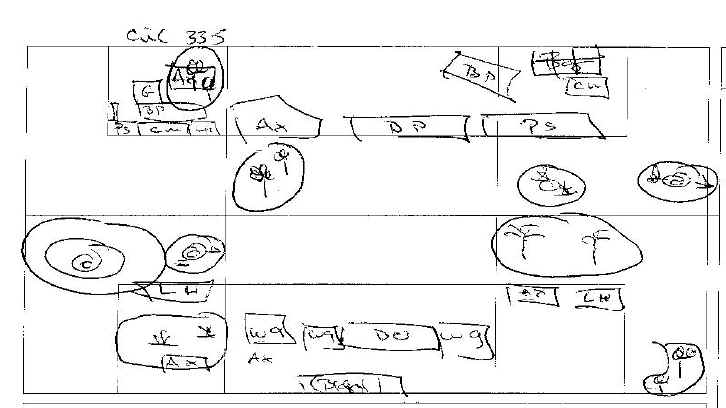
THE RIGHT FLANK
The wood I had paced in the central sector forced the enemy CinC into a wide position on my left and I realised that with what I had facing them, my best best was to fight a delaying action here, to soak up the pressure and delay their arrival into the central part of my front.
Accordingly I pushed forwards a screen of Lh through the rough going, and prepared to sacrifice a couple of wagons to delay and separate the blades, making them choose between coming forwards to attack my lurking auxilia to the rear of a large area of RGO, or perform a difficult wheel into the centre.
This attempt to split the blades and camelry up worked, and some blades peeled off to attack the wagons, and some ploughed straight on, meaning my auxilia were not outnumbered - the camels were also forced wide by the need to avoid the wagons and make room for the blades, and struggled to get back into the game.
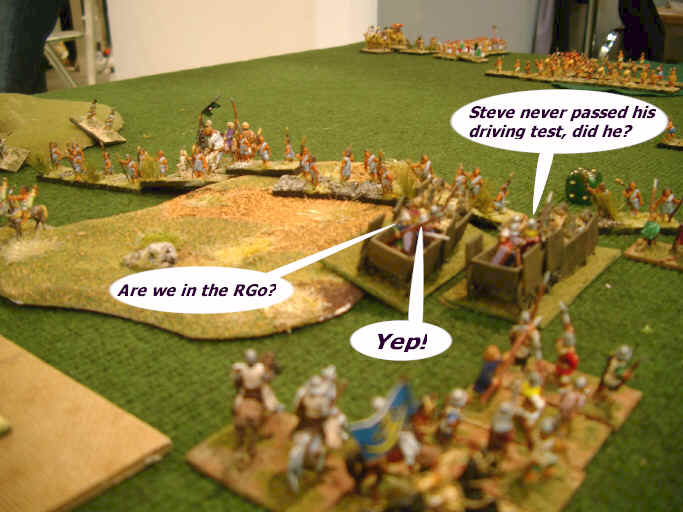
The Quatabans advanced fiercely, eventually overwhelming the wagons, but this then drew them out into the open where cavalry and knights lurked threateningly - not fancying their chances, they fell back into the safety of the RGo areas. The battle lines hardened up into a face off, with the weakened Quataban command almost at my base edge, and at right angles to the initial deployment.
THE CENTRE
In the middle there were 2 unreliable allies - the Teutons and a massive Quataban command - facing off, supported by parts of my CinC'c command. The Quatabans were first to become reliable, and wheeled in to advance towards my CinC, wheeling off some elements to catch my wagons on the left flank in a pincer movement with their CinC's attack.
This then spurred the Teutons into action at the ideal time,
and they charged forwards in a solid line towards the temptingly isolated
blades. 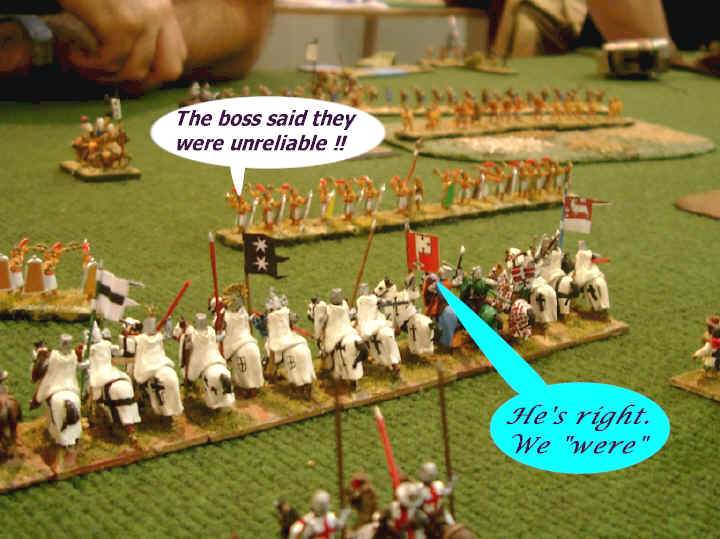
The Lithuanian CinC had little to do save stand and brace himself and his hussite flailmen, and so spent pips on pushing a line LH through a gap in the Quataban lines, as a nuisance maker and to soak up pips as the Quataban allied general was forced to personally intervene to protect his own baggage
The Quataban blades were quickly (instantly) skittled down like, erm, skittles by the Teutonic charge, leaving a marauding mass of dangerous knights to support my left flank and pin the blades back into the rough, and stare impotently at the mass of auxilia who were flicking the V's at the Germans from the safety of the wood. Their stunning success had still not come that close to breaking any of the Quataban commands, and so the Teutons, bereft of targets, were forced into patrolling the open ground and threatening careless generals for the rest of the game.
THE RIGHT.
The right hand flank was dominated by a huge orchard into which a mass of Quataban infantry and auxilia had advanced, whilst their blades stood on a hill to the rear, waiting for the time (and the space!) in which to attack.
My smallest LH command initially was positioned to prevent anyone coming through the orchard, but as the game developed, this job was taken by the CinC's auxilia, so the LH probed a possible opportunity on the far right to try and run down some psiloi and possibly force an opening to outflank the enemy (and soaking up pips anyway), taking a risk or two along the way..
The quick demolition of the central commands blades meant the blades on my right were not coming off their protective rough hill, so the only other chance was to attack the auxilia and psiloi in the orchard. With pips to burn, the Lithuanian CinC moved all of his auxilia up individually, and instructed some blades to join in an attack through the fruit trees into a distracted enemy as the Teutons chased the Arab general round the table...
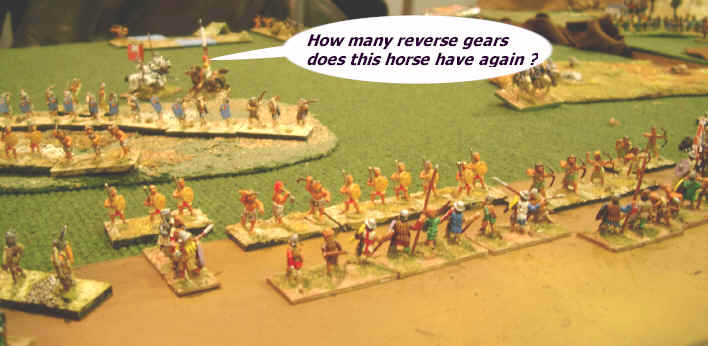
The Lithuanian auxilia did well - but with command and control problems abounding for both sides, the attack petered out before anything decisive could happen, and with the casualties in the middle having battered one Quataban command I was already winning 6-4 on the "25% losses to a command" rule. This meant there was little incentive for me to risk elements of my CinC's command in a bid to achieve a "proper" 6-4, and so as the game finished (after 18 bounds) I had recorded a 6-4 win.
Post Match Analysis
With the initial terrain this was always going to be an unwinnable game for me, and so after 5 pints at lunchtime I had to concentrate really hard to come up with a defensive plan that could give me the opportunity of nicking a command. Breaking up the Quataban attack with additional terrain (in the form of the wood) was vital.
This aided my plan to concentrate on fighting just one command - but even with this, the depth at which the Quatabans deployed their filler, and the way in which my own auxilia were committed to other parts of the table meant the 25% rule was the only way to get a 6-4.
From a rules perspective, it did seem odd that I was discouraged from attacking towards the end of the game as with a 6-4 in the bag already, there was no gain for me in actually killing a command.
next set of pics and reports


